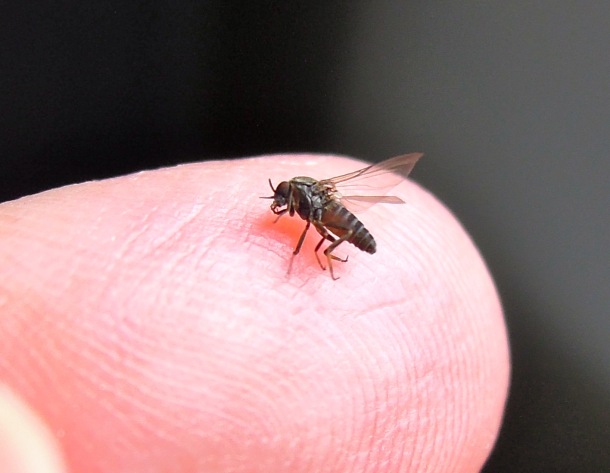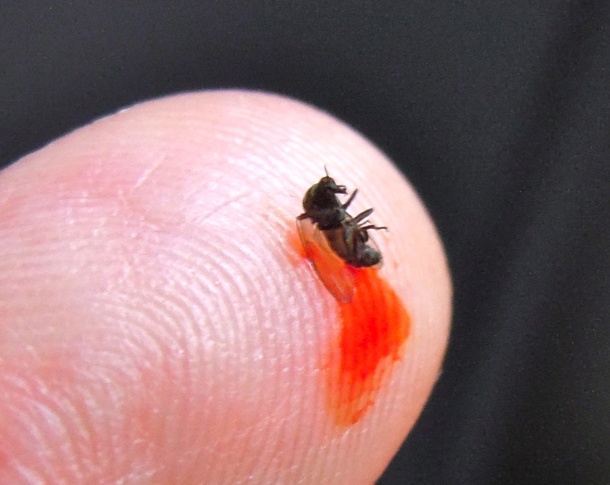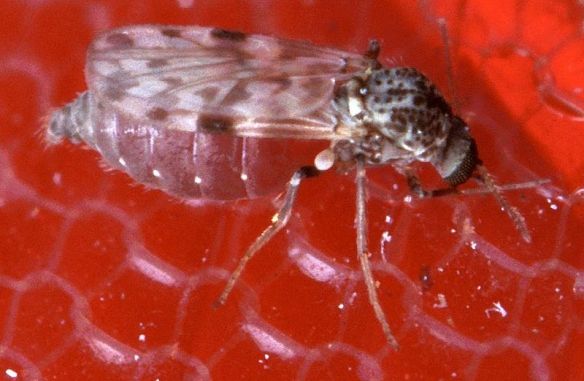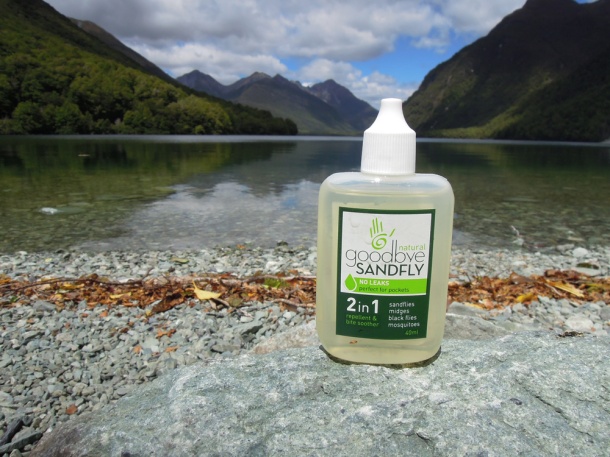The bane of wetland scientists is biting insects, which can be distracting when you are trying to work and even dangerous as disease vectors. Most of us have horror stories about encounters with swarms of mosquitoes, blackflies, and no-see-ums. Here in New Zealand’s fiordland (that’s how they spell it here), we’ve encountered the notorious “sandfly”, which inhabits coastal areas as well as inland lakes and streams. The area around Milford Sound is infamous for these critters.
Although the locals refer to these Dipterans as sandflies, they are actually what are called blackflies elsewhere and belong to the family Simuliidae. There are 13 species here in New Zealand but only two of them bite: Austrosimulium australense and A. ungulatum. I was expecting something more similar to no-see-ums, which can be really annoying. But these insects are much larger (about 3 mm in length) and slower than their Northern Hemisphere cousins. Apparently, if you walk fast, you can escape them. Also, according to local wisdom, they are attracted to black or dark colors.
On our various excursions that took us near water, we saw a few of the NZ sandflies (see photos below) but not in huge swarms. The largest numbers we encountered were in the tour bus that took us to Doubtful Sound.
“New Zealand Sandfly” (Austrosimulium sp.)


When biting, they apparently pierce the skin, causing a drop of blood to well up, which they then suck up. The histamine they inject to prevent blood clotting leads to swelling and itching. Note that the biting midges (no-see-ums) in the family Ceratopogonidae are often incorrectly referred to as sandflies, which are in a different family. Fortunately, biting midges in the U.S. and the New Zealand “sandflies” carry no diseases (Leishmaniasis) as do the sand flies (Phlebotominae) in Central America.
Biting Midge (Ceratopogonidae); Photo Source: U.S. Dept. of Agriculture

I haven’t been bitten yet so cannot attest to whether the bite is painful or produces itching (I normally do not react to no-see-um bites). No-see-um bites are painful and even maddening, especially when they get into your scalp and ears. The NZ sandflies did not seem to be ambitious enough to go for the scalp or various crevices and gaps in clothing. But perhaps we did not encounter sufficient numbers to get the full experience.
In any event, we consulted some locals about repellents and the top recommendation is an oily concoction called Goodbye Sandfly, an apropos and rhythmical name. We tried it out while having lunch at the side of a lake.
There were a few sandflies here, and we observed their behavior toward Goodbye Sandfly. They buzzed around our exposed skin coated with the repellent, circled as if deciding whether to land, then abruptly departed. The ingredients include essential oils of Eucalyptus, Lavender, Pine, Manuka, Tea Tree, and Lemongrass in a base of expeller- pressed Sweet Almond Oil. We hypothesized that the sandflies were repelled by the odors of these oils. None landed on my exposed, oiled skin. Ads for it also claim that it is good for bites and is compatible with sunscreen (providing an SPF of 2).
On the other hand, recommendations for repellents that I’ve seen online are adamant about the necessity of DEET in high concentrations to ward off these little bugs. This is reminiscent of the arguments about the best way to repel no-see-ums: oily concoctions such as Skin-So-Soft versus DEET. In our experience, DEET does not work against biting midges, but Skin-So-Soft does, although you must apply it frequently.
I’m quite curious now to try this brand against Louisiana no-see-ums. We know Skin-So-Soft works, and I’ve tried other oil-based, natural repellents, but I was impressed with this one. Of course, we need to try it out here where the numbers of NZ sandflies are much higher. Maybe we’ll get a chance here in Queenstown, which is situated along a huge lake, Lake Wakatipu.
